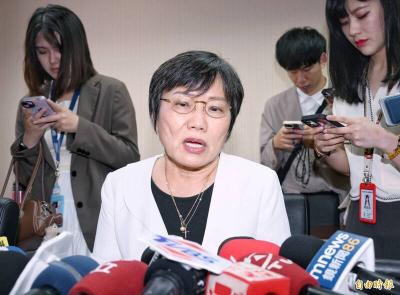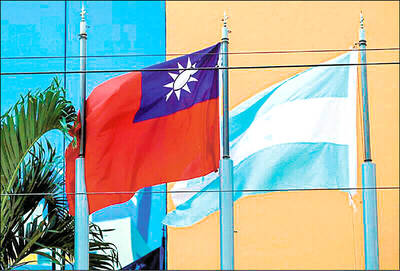“Unmanned aerial vehicles [UAV] and helicopters will play a bigger role in anti-terrorism missions in the future, both at home and abroad,” Ma Tenglong (馬騰龍), a marketing manager at the Aviation Industry Corp of China (AVIC), China’s largest aircraft manufacturer, said at the 4th China (Beijing) International Exhibition and Symposium on Police Equipment and Anti Terrorism Technology and Equipment (CIPATE) earlier this month.
Although Beijing’s interest in UAVs has been known for years, it wasn’t until the 8th China International Aviation and Aerospace Exhibition (Airshow China) in Zhuhai, Guangdong Province, in November last year that the scope of Chinese capabilities in that department was fully unveiled. In all, more than 25 models of UAVs were showcased and a good number of them had dual-use capabilities, meaning that they had both civilian and military applications.
While the development and deployment of unmanned vehicles by the Chinese military and security apparatus adds to an already complex situation in Asia, it is a perfectly natural consequence of China’s rise and Beijing is only following the example set by other modern militaries the world over.
However, what is more worrying, experts say, is that Chinese officials appear to have been impressed by, and to have learned lessons from, precedents set by the US.
“The PLA [People’s Liberation Army] has probably been the keenest watcher of the use of the latest technology by US forces,” Steve Tsang (曾銳生), director of the China Policy Institute in the School of Contemporary Chinese Studies at the University of Nottingham, told the Taipei Times. “The PLA tries to learn as much as it can from the application of new technology in the ‘battlefield’ and picks up some of the language used, too.”
Coverage on May 20 by the state-owned China Daily of the CIPATE show underscores that interest.
“In anti-terrorism operations outside China — including the recent killing of Osama bin Laden by the United States — unmanned aerial vehicles and helicopters have played an important role in reconnaissance and also carry out air-to-ground attack missions,” it said.
One of the drones on display at the CIPATE, held on May 19 through May 21, was AVIC’s “Pterodactyl,” which can be used for surveillance and reconnaissance as well as air-to-ground attack missions. Its mission time extends to 20 consecutive hours and it can operate at an altitude of 5,000m.
Also on display was a variety of domestically produced weapons systems for UAVs, reports said.
However, as Roger Cliff, an expert on the Chinese military at the Project 2049 Institute, told the Taipei Times, we should approach comments like those made by Ma with skepticism.
“AVIC [though state-owned] is not part of the Chinese military, so anything said by AVIC employees should not be construed to represent the view of China’s military or civilian security apparatus,” he said. “Ma is a marketing manager and his statements were made at an international exhibition of police and counterterrorist equipment. He is trying to promote the sales of UAVs abroad, not making an authoritative statement about how UAVs will be used in China.”
In addition, many of the systems displayed at these exhibitions are developed for export only and are never procured by China’s domestic security forces, Cliff said.
Still, it would not be surprising if Chinese military and nonmilitary forces eventually began using UAVs outside China’s territory, he said.
The Chinese, like others, appear to have embraced the notion of “extraterritoriality” in UAV use and this stems principally from the fact that their use is seen as more permissible and less controversial when they are caught or shot down over foreign territory.
“Getting caught with a UAV over another country’s territory doesn’t seem to be as provocative as sending manned spy aircraft,” Cliff said. “An Iranian UAV was shot down over Iraq a year or so ago and it was treated as a minor incident, like discovering that a foreign diplomat had been engaged in espionage or something.”
“Compare that to what happened when Gary Powers was shot down over the Soviet Union and captured,” Cliff said, referring to the May 1, 1960, shooting down of a US U-2 spy plane near Svedlovsk, in the former Soviet Union.
“China is regularly accused of violating the Line of Actual Control along the China-India border with foot patrols, so it’s hard to see how sending UAVs over disputed areas would be considered qualitatively worse. Getting caught with one over Indian territory that China doesn’t claim would undoubtedly upset New Delhi, but certainly wouldn’t be considered an act of war,” he said.
Already, the Hindu newspaper reported on May 22 on what appears to have been a UAV sighting by the Indo-Tibetan Border Police (ITBP) force on a recent patrol in the difficult high terrain along India’s disputed mountainous border with China. (The sightings by the ITBP could not be documented with certainty, given the lack of sophisticated equipment at many outposts in India’s border regions.)
Military experts regard the incident as the latest indication of China’s expanding UAV program.
Another worrying possibility emerging from China’s embrace of UAV technology is that its unmanned missions could extend from traditional border surveillance and be applied to a definition of terrorism that is far more vague than that which has regulated US operational use in places like Pakistan, Afghanistan and Yemen.
In fact, Beijing will very likely rely on UAV capability to address the so-called “three evils” of “terrorism, separatism and religious extremism,” meaning that “separatist” leaders from Xinjiang, Tibet and Taiwan could all be fair game.
Tsang said drone technology would likely apply to all such scenarios — including Taiwan.
“If there should be a military confrontation [over Taiwan], the PLA will unquestionably use all its most advanced weaponry. Drones and stealth helicopters would be used for ‘decapitation’ [attacks],” he said.
Alexander Huang (黃介正), a senior associate at the Center for Strategic and International Studies, said the utility of UAVs was not limited to “anti-terrorist” operations, but was in fact very wide in conventional military actions, from reconnaissance to decapitation.
“For China, the UAV could be a useful, lower cost, low-intensity device in the ISR [intelligence, surveillance and reconnaissance] missions as part of its A2/AD [anti-access, area-denial] strategy,” over Taiwan, Huang said.
The implication is that Chinese UAVs could soon, if they aren’t already, enter foreign airspace or international waters to conduct reconnaissance, surveillance and perhaps even targeted killings, much as the US has done in recent years.
Beyond Taiwan, the Tibetan government-in-exile could present an opportunity for UAV use by the PLA, especially if the context were to change following the recent change of leadership there.
Should newly elected Tibetan government-in-exile Prime Minister Lobsang Sangay adopt, as some predict, a more “reactionary” policy vis-a-vis the Chinese occupation of Tibet, it is very possible that at some point in the future China could deploy drones in areas along the Tibetan Plateau bordering Dharamsala, India, where the government-in-exile has been based since the Dalai Lama’s exile. During the election earlier this year, Sangay said he would move from Boston, Massachusetts, to Dharamsala if he were elected.
As China gains strength and self-confidence, it can be expected to begin exercising certain “rights” that for the past two decades have been principally a US prerogative as a result of its military supremacy. As that balance shifts, China will be the likeliest challenger of that right and by virtue of the relatively low cost and “acceptability” of deployment, UAVs could be the first expression of that challenge.
“The possible threat is not only to Taiwan, but to those forces operating along the Western Pacific,” Huang said.

Chinese Nationalist Party (KMT) Chairman Eric Chu (朱立倫), spokeswoman Yang Chih-yu (楊智伃) and Legislator Hsieh Lung-chieh (謝龍介) would be summoned by police for questioning for leading an illegal assembly on Thursday evening last week, Minister of the Interior Liu Shyh-fang (劉世芳) said today. The three KMT officials led an assembly outside the Taipei City Prosecutors’ Office, a restricted area where public assembly is not allowed, protesting the questioning of several KMT staff and searches of KMT headquarters and offices in a recall petition forgery case. Chu, Yang and Hsieh are all suspected of contravening the Assembly and Parade Act (集會遊行法) by holding

PRAISE: Japanese visitor Takashi Kubota said the Taiwanese temple architecture images showcased in the AI Art Gallery were the most impressive displays he saw Taiwan does not have an official pavilion at the World Expo in Osaka, Japan, because of its diplomatic predicament, but the government-backed Tech World pavilion is drawing interest with its unique recreations of works by Taiwanese artists. The pavilion features an artificial intelligence (AI)-based art gallery showcasing works of famous Taiwanese artists from the Japanese colonial period using innovative technologies. Among its main simulated displays are Eastern gouache paintings by Chen Chin (陳進), Lin Yu-shan (林玉山) and Kuo Hsueh-hu (郭雪湖), who were the three young Taiwanese painters selected for the East Asian Painting exhibition in 1927. Gouache is a water-based

Taiwan would welcome the return of Honduras as a diplomatic ally if its next president decides to make such a move, Minister of Foreign Affairs Lin Chia-lung (林佳龍) said yesterday. “Of course, we would welcome Honduras if they want to restore diplomatic ties with Taiwan after their elections,” Lin said at a meeting of the legislature’s Foreign Affairs and National Defense Committee, when asked to comment on statements made by two of the three Honduran presidential candidates during the presidential campaign in the Central American country. Taiwan is paying close attention to the region as a whole in the wake of a

OFF-TARGET: More than 30,000 participants were expected to take part in the Games next month, but only 6,550 foreign and 19,400 Taiwanese athletes have registered Taipei city councilors yesterday blasted the organizers of next month’s World Masters Games over sudden timetable and venue changes, which they said have caused thousands of participants to back out of the international sporting event, among other organizational issues. They also cited visa delays and political interference by China as reasons many foreign athletes are requesting refunds for the event, to be held from May 17 to 30. Jointly organized by the Taipei and New Taipei City governments, the games have been rocked by numerous controversies since preparations began in 2020. Taipei City Councilor Lin Yen-feng (林延鳳) said yesterday that new measures by